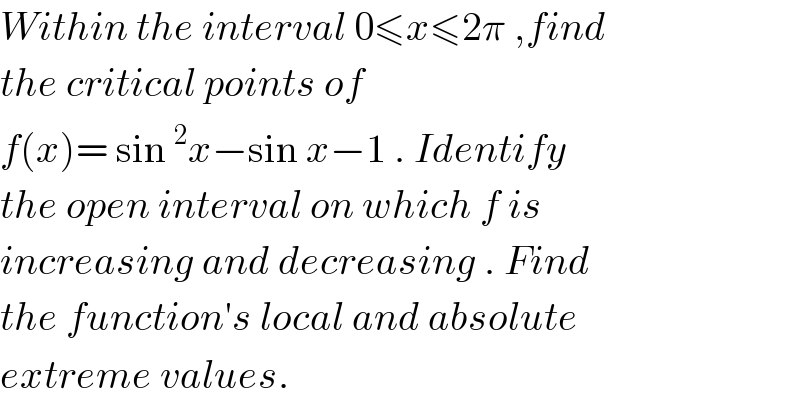
Question and Answers Forum
Question Number 123812 by benjo_mathlover last updated on 28/Nov/20

Answered by liberty last updated on 28/Nov/20
![The function f is continous over [ 0,2π ] and differentiable over (0,2π) so the critical points occur at the zeros of f ′ in (0,2π) . We find f ′(x)= (2sin x−1)cos x . The first derivative is zero if only if sin x=(1/2) or cos x=0 . So the critical points of f in (0,2π) are x=(π/6); ((5π)/6); (π/2); ((3π)/2) they partition [0,2π] into open intervals as follows interval : (0,(π/6)) ((π/6),(π/2)) ((π/2),((5π)/6)) (((5π)/6),((3π)/2)) (((3π)/2),2π) sign of f ′ : − + − + − behavior of f : dec inc dec inc dec there is a local minimum value of f((π/6))=−(5/4), a local maximum value of f((π/2))=−1, another local minimum value of f(((5π)/6))=−(5/4) and another local maximum value of f(((3π)/2))= 1. The endpoint value are f(0)=f(2π)=−1. The absolute minimum in [ 0,2π ] is −(5/4) occuring at x=(π/6) and x=((5π)/6); the absolute maximum is 1 occuring at x=((3π)/2).](Q123818.png)
| ||
Question and Answers Forum | ||
Question Number 123812 by benjo_mathlover last updated on 28/Nov/20 | ||
 | ||
Answered by liberty last updated on 28/Nov/20 | ||
![The function f is continous over [ 0,2π ] and differentiable over (0,2π) so the critical points occur at the zeros of f ′ in (0,2π) . We find f ′(x)= (2sin x−1)cos x . The first derivative is zero if only if sin x=(1/2) or cos x=0 . So the critical points of f in (0,2π) are x=(π/6); ((5π)/6); (π/2); ((3π)/2) they partition [0,2π] into open intervals as follows interval : (0,(π/6)) ((π/6),(π/2)) ((π/2),((5π)/6)) (((5π)/6),((3π)/2)) (((3π)/2),2π) sign of f ′ : − + − + − behavior of f : dec inc dec inc dec there is a local minimum value of f((π/6))=−(5/4), a local maximum value of f((π/2))=−1, another local minimum value of f(((5π)/6))=−(5/4) and another local maximum value of f(((3π)/2))= 1. The endpoint value are f(0)=f(2π)=−1. The absolute minimum in [ 0,2π ] is −(5/4) occuring at x=(π/6) and x=((5π)/6); the absolute maximum is 1 occuring at x=((3π)/2).](Q123818.png) | ||
| ||